Advertisement
Advertisement
Dollar Pessimism is Back
Published: Oct 17, 2019, 08:27 UTC
The dollar declined dragged by domestic economic data with optimistic markets hopes for the Brexit deal. Over the last week, the dollar index lost about 1.4%, while EURUSD strengthened by 1.2% and GBPUSD jumped by 5.5%.
The US retail sales figures released on Wednesday were down 0.3% in September, against expected the same increase. The decline in retail sales in the US, the first after six months of growth, turned out to be an unpleasant surprise for the markets. Weak economic data resulted in a decrease of the dollar index to the area of September lows to 97.60.
The drop in US retail activity paints a more gloomy economic picture of the impact of trade wars on the economy. Before that, economists noted that strong consumer demand should help the US to avoid a deep recession. In our view, Americans in previous months were buying in advance, trying to prevent prices hike after imposed tariffs on Chinese imports. Lately, there was an apparent de-escalation, and some delays in tariff increases were announced, which may correct consumer demand. If we are right, sales may continue to decline in the coming months as consumers bought some goods in advance.
A similar situation may also be in the housing market and industrial production, the latest date for which are published today at the beginning of the US session. Last month’s figures showed a sharp increase – industrial production jumped by 0.6% and housing starts by 7.7% – so now there is a risk of a correction to more familiar levels. For the dollar, this may be an unpleasant surprise, as it will bring back the expectations of new rate cuts to the markets.
In the dollar quotes, by most part included expectations of the third rate cut on October 30, but strong data and hopes for progress in trade negotiations between China and the United States reduced the chance of another rate cut at the beginning of next year from 40% to 30%. The end of a period of healthy statistics could bring back the pressure on the dollar if market participants demand more easing from the Fed.
This article was written by FxPro
About the Author
Alexander Kuptsikevichcontributor
Alexander is engaged in the analysis of the currency market, the world economy, gold and oil for more than 10 years. He gives commentaries to leading socio-political and economic magazines, gives interviews for radio and television, and publishes his own researches.
Did you find this article useful?
Latest news and analysis
Advertisement
